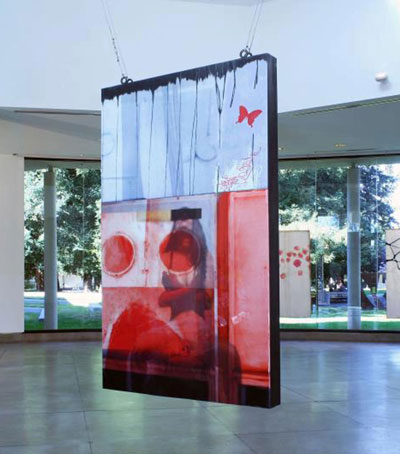
Upon entering into the Triton Museum of Art, you will see a hanging piece of art entitled “The Crazy Pink is the Crazy Pink, A Red Rose, A Cry for More than Flower Color” and might wonder what you just walked into. The wooden slab shows a woman sitting in a chair, legs spread – a red rose strategically placed between her thighs. Red elbow-length gloves cover her arms, which she then uses to cover her bare breasts. She looks up, but her eyes have been blacked out. Above her sits denim colored wall that seemingly has nothing to do with the woman below. Black streaks of paint run down the blue creating a fence-like image and a single butterfly is flying towards the upper right corner of the painting.
“The Crazy Pink is the Crazy Pink, A Red Rose, A Cry for More than Flower Color” is one of many images currently at the Triton Museum of Art and part of a series by Silvia Poloto entitled Rosa Louca Dos Ventos. The paintings, all abstract in nature, still tell a story. But, the story might not be as easily read and is often open to interpretation.
In Poloto’s piece, the positioning of the female’s body is sexually suggestive. The rose could be a symbol for love or femininity. The position of her head, tilted up toward the sky, could be used to portray longing. The black paint streaks might mean sadness as they run from the top to the bottom, like tears streaming down a person’s face. The butterfly could mean a new sense of freedom, or a desire to obtain freedom. A red blanket of color overlays the woman. Red typically symbolizes passion or rage. But what is this, and Poloto’s other images, really about?
The answer is best found in the artist’s statement.
“Eight months ago I lost my mother. Four years ago I lost my father. Three years ago I lost my husband. One year ago I lost my best friend. The ache, the sorrow, the grief, the tears…During this period my identity as a wife, daughter, mother and friend shifted and transformed. My identity as both a woman and artist expanded.
“…I wanted to embody the freedom my brother possessed; I wanted my brain to be challenged and worshiped. I wanted to be regarded for my mind not for my looks. I ended up becoming an electrical engineer like my brother, and also completed a masters degree in business administration, as if to prove there was more to me than red scribbles.
“…Rosa Louca Dos Ventos was inspired by the autobiographical and developed as I accepted all sides of myself…It also celebrates our shared experience, the human condition and its cycle of death, rebirth, and transformation.
“…The symbols-thorns, roses and thread-are the elements of the soul…The rose for me, is both soul and female spirit, a celebration of womanhood. The symbolism of the imagery and the meaning behind the use of color has become more critically important in my work. After completing the project, I discovered that a blue rose is the symbol of the impossible and took it as a fitting metaphor. I have embraced my roles as woman, artist, mother. I see myself for what I am: expressive and exuberant, unique yet connected.”
In order to fully understand Poloto’s work, one needs to take the time to really look at the pieces to find the connections – roses, dots, barbed wire, and thread. Take the paintings apart and put them back together. Eventually Poloto’s pain and loss will be felt.
Poloto’s exhibit is on display until May 2 at the Triton Museum of Art, 1505 Warburton Avenue in Santa Clara. For more information visit www.tritonmuseum.org.
